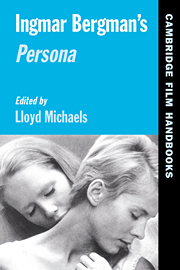Book contents
- Frontmatter
- Contents
- Acknowledgments
- List of Contributors
- Bergman and the Necessary Illusion
- 1 Bergman's Persona through a Native Mindscape
- 2 Persona and the 1960s Art Cinema
- 3 Bergman's Persona
- 4 Scenes from the Class Struggle in Sweden
- 5 Persona and the Seduction of Performance
- 6 Feminist Theory and the Performance of Lesbian Desire in Persona
- Filmography
- Reviews of Persona
- Select Bibliography
- Photographic Credits
- Index
1 - Bergman's Persona through a Native Mindscape
Published online by Cambridge University Press: 29 January 2010
- Frontmatter
- Contents
- Acknowledgments
- List of Contributors
- Bergman and the Necessary Illusion
- 1 Bergman's Persona through a Native Mindscape
- 2 Persona and the 1960s Art Cinema
- 3 Bergman's Persona
- 4 Scenes from the Class Struggle in Sweden
- 5 Persona and the Seduction of Performance
- 6 Feminist Theory and the Performance of Lesbian Desire in Persona
- Filmography
- Reviews of Persona
- Select Bibliography
- Photographic Credits
- Index
Summary
Throughout his creative life Ingmar Bergman has acknowledged his cultural roots in Swedish literature, theater, and film. This being the case, it seems a paradox that his filmmaking career would come to fruition only after his work gained acceptance on the international film circuit in the mid-1950s. But a brief look at the two films that catapulted Bergman into visibility outside his native Sweden – Smiles of a Summer Night (1955) and The Seventh Seal (1956) – suggests that his artistic inspiration drew on a combination of internationally established genre patterns and native cultural contexts. Smiles of a Summer Night followed the structure of the European musical operetta while also emulating the erotic badinage of Swedish filmmaker Mauritz Stiller (Eroticon, 1918), later found in the films of Ernst Lubitsch and René Clair. The Seventh Seal, an existential road movie set in the fourteenth century, built on the medieval morality play, Dürer engravings, and mural church art, revitalized as a dramatic genre in August Strindberg's station or quest dramas from the last turn of the century (To Damascus; A Dreamplay). In other words, Bergman's artistic motifs and structures are in many ways as international as they are native, making them both “exotic” and recognizable to foreign viewers. Ultimately, however, his aesthetic vision appears to be filtered through an indigenous Swedish mindscape. This seems also to be the case in terms of the genesis and dramaturgical pattern of Persona.
By the time he made Persona Bergman's reputation in the cinema was global, and his film quickly became recognized as a self-reflexive masterpiece, exposing a screen narrative in the making.
- Type
- Chapter
- Information
- Ingmar Bergman's Persona , pp. 24 - 43Publisher: Cambridge University PressPrint publication year: 1999



